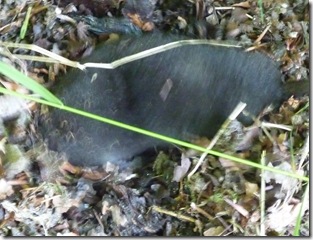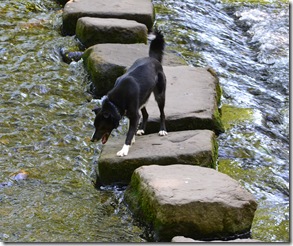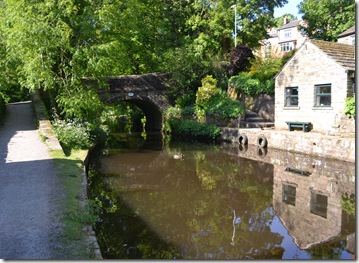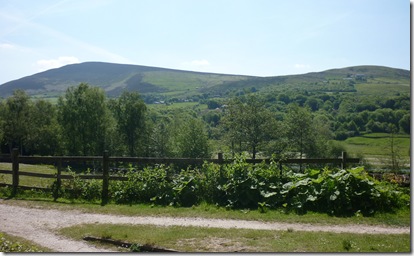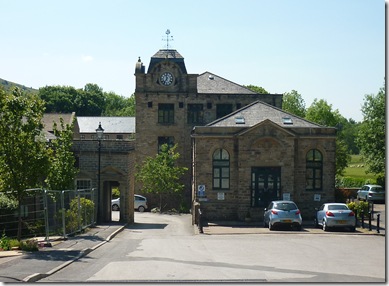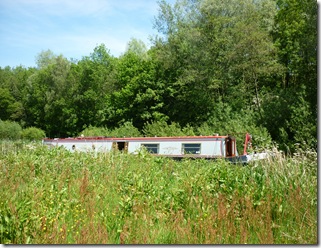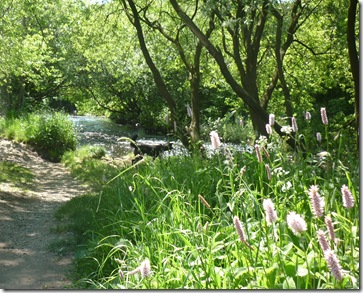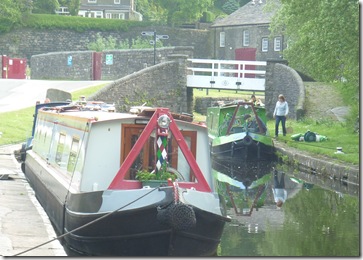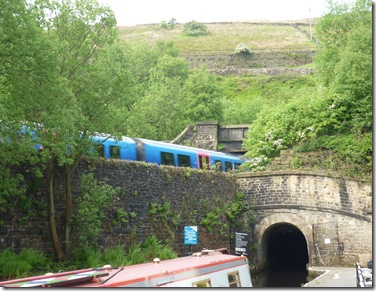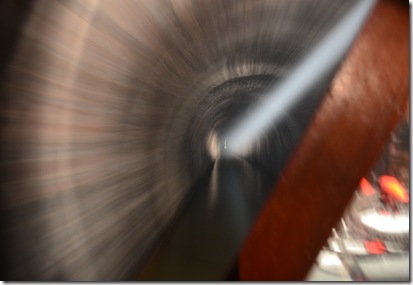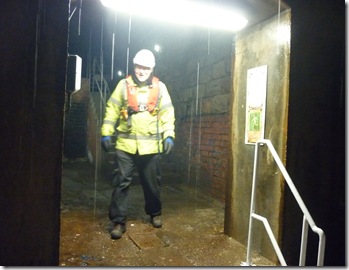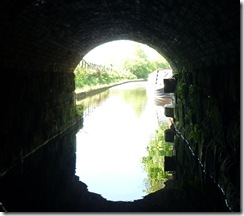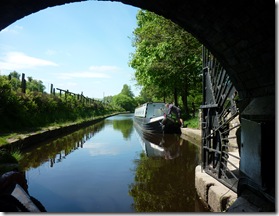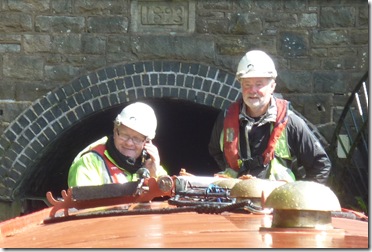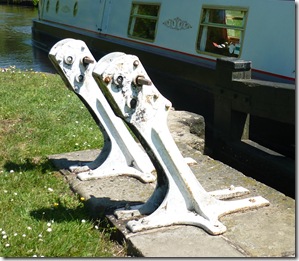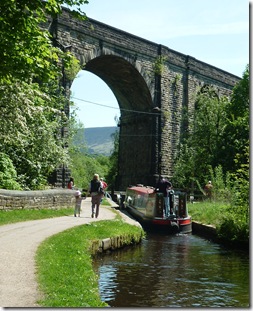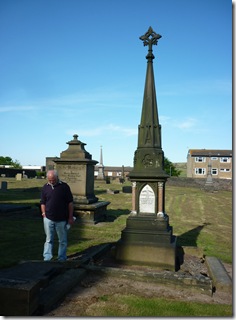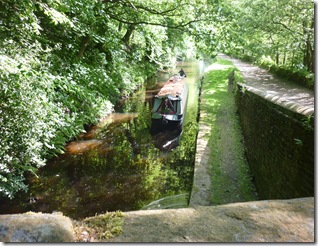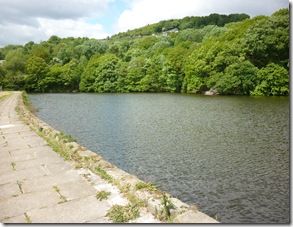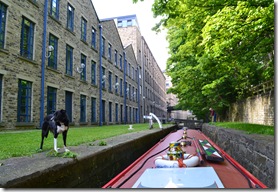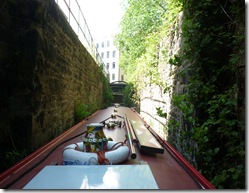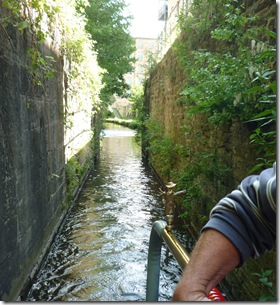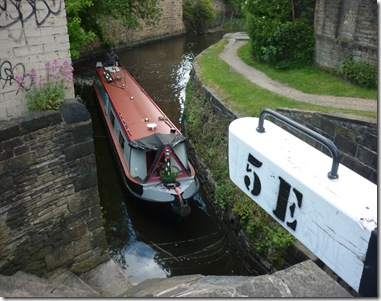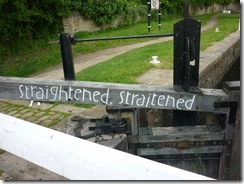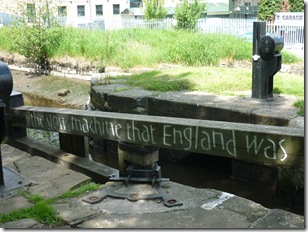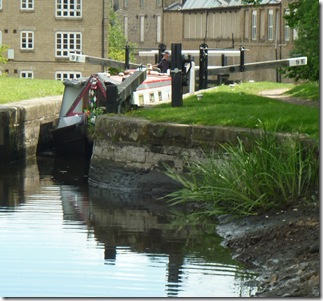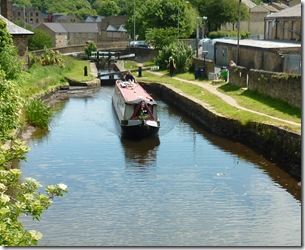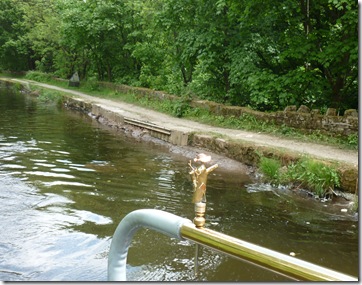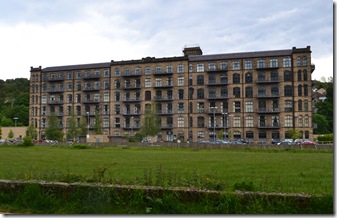A lovely bright sunny morning once more as we prepared to pull pins and head away from the countryside – I took a quick snap before I leapt on my bike to buzz down to the lock.
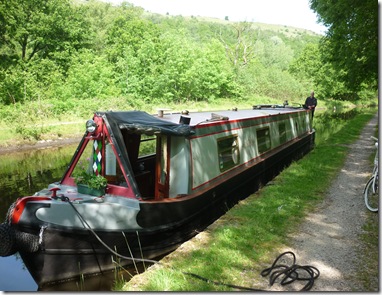
Above lock 9W there was a depth gauge and sign. At first I wondered why, as the river is well below the canal at this point and they don’t share the channel on the Huddersfield – but if you look carefully you can see that the colours are reversed from the order you see on river sections of canal. Unfortunately the sun was so bright my camera couldn’t cope and I don’t have the knowledge/software to correct it.
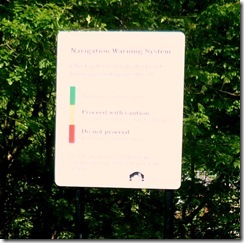
This is a very short pound and the level is obviously prone to dropping. The red band on the indicator at water level (above the lock) is concealed when the water is deep enough for passage rather than too deep for safety. It was covered in mud, but we could see it was in the green and we had no problems. It became increasingly hot and humid as we stopped at the Grove Road Bridge services and then descended the last of the rural locks.

Almost immediately we were passing under a pylon
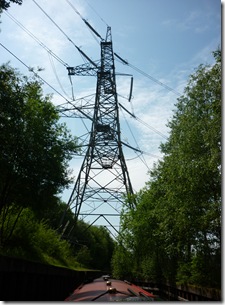
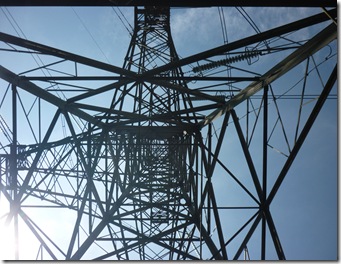
The sun was still bright enough to make photography awkward. Industry was encroaching now on the approach to Stalybridge and we stopped on the visitor moorings between Tesco and its car park. We were glad we didn’t come down here last night – the towpath is covered in goose poo and there is nowhere to take a dog. I even had to climb through the railings to get into the car park and over the footbridge to the store – if there was a gap it must have been a long way back up the way we came. The good thing about this spot, apart from convenience for shopping, is the excellent recycling facilities the other side of the car park. Clean and tidy, room in the bins for everything and now room for my shoes in the bottom of the wardrobe again.
We didn’t stay long and were soon in Armentieres Square. The canal goes through the middle of the square and Lock 6W was built during its restoration. I think in poor weather or winter the square must be pretty bleak, with its roads, expanses of paving and the boarded-up Mill Pond pub. People were strolling about in the sunshine but a lot seemed to have no interest in the boat at all, which we thought was quite unusual especially as it’s not a busy canal. Not a bit like Banbury, for example! We did have an audience, though they just watched from their benches. On one side is this interesting sculpture.
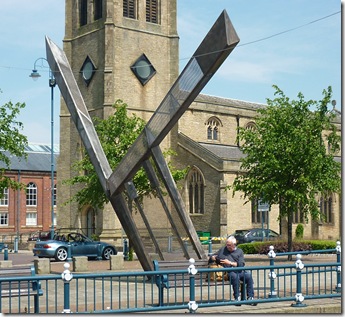
I could probably had got a better photo if I’d crossed over and gone towards the church but then the sun would have been in my eyes. I had to look it up to find out what the sculpture represents – it’s a pair of lock gates, obvious when you know, and there is a better view on the link. It is set up to be a sundial.
At the next lock we spied nb Yorkshire Rose, one of our tunnel companions. They had spent a quiet night on the Armentieres Square moorings. We followed them down the remaining locks before turning in at Portland Basin for fuel.
On the way we passed under this bridge where the air was full of whirling birds. I think they were sand martins rather than house martins and appeared to be nesting in holes under the bridge parapet.

To get to the diesel point we had to turn onto the Peak Forest canal, then almost immediately into the narrow boatyard arm. With little space and plastic boats moored either side of the arm I nipped up to the bow to ask a boater where the fuel pump was. Oh here, he said, and pulled his little cruiser out of the way to leave just enough room for us to pull in. We still had to stick our bow out past the narrowboat moored in front of us for the hose to reach. There was nowhere to turn, so afterwards Dave had to reverse (perfectly, with only about a foot either side) between the two cruisers so we could be on our way. I should have taken a photo but was rather too occupied in checking our distance from the Tupperware.
At Dukinfield Junction, where the Peak Forest canal meets the Ashton and Huddersfield Narrow, is the Ashton Canal Warehouse, built in 1834 and restored in 1998. The Portland Basin Museum is housed in the warehouse and the Wooden Canal Boat Society has boats here.

I didn’t have a chance to take pictures of the boats on the way in as we weren't sure where the entrance to the Peak Forest was. A visit to the museum will have to wait until we come this way again.
We continued down the Ashton to the marina, noting how the wind was getting up while we were still half a mile away! In the stiff breeze we needed two goes to get into our mooring but were all sorted before the drizzle started. Jane, who lives aboard there, had kept an eye on our car for us, even moving it a couple of times when the space was needed for craning a boat. Thanks Jane! I have to say this is one of the friendliest places we have ever stayed.
It was a damp evening and we treated ourselves to a meal in the excellent Giovanni's a short walk away.
10 locks, 6 and a half miles.
On Saturday morning we loaded the car between showers – the weather is nothing like as bad as the forecast had threatened. Apart from half an hour at tickover speed on the M6 we had a good journey home.
Stats for the trip, the South Pennine Ring:
197 locks (92 narrow, 105 broad; Tuel Tunnel lock is counted as 2). 73 miles 6 furlongs, 78.5 engine hours, 6 moveable bridges and 8 tunnels including the wonderful Standedge.
Year’s total so far:
229.5 miles, 303 locks (117 broad, 186 narrow), 11 moveable bridges, 14 tunnels, 167 engine hours.
The blog is at last up to date, so where shall we go next? Back to Manchester probably, then maybe further along the Bridgewater and/or the Weaver. We won’t go back up the Huddersfield, not this year anyway!
